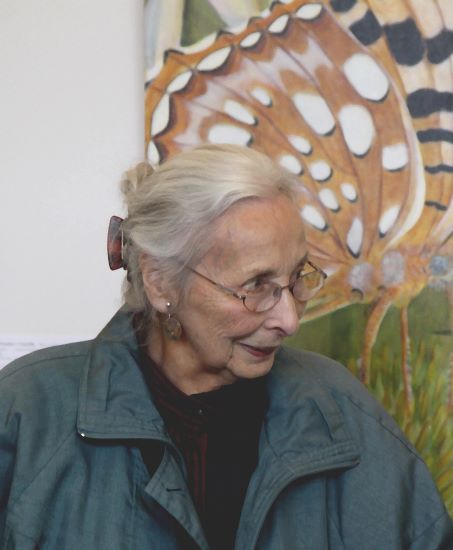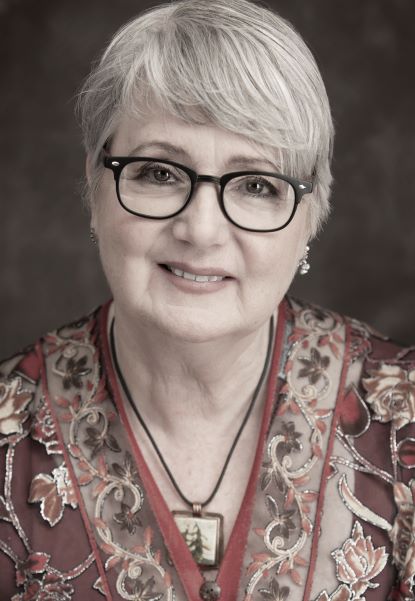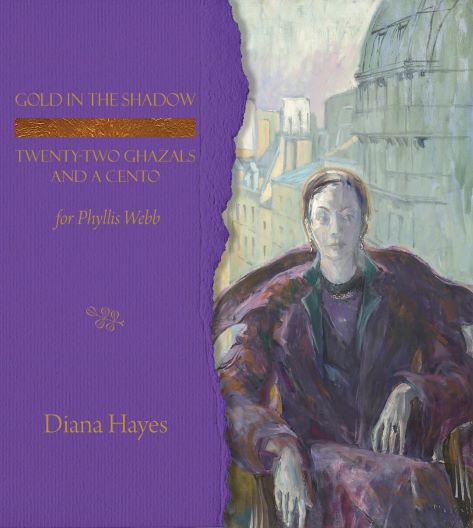Diana Hayes new book of poetry, GOLD IN THE SHADOW: TWENTY-TWO GHAZALS AND A CENTO for Phyllis Webb (Rainbow Publishing, 2021), is exquisite in every detail: the design by Pat Walker Design and the papers used; the purple and gold of the cover; the size of the book; and the finely-rendered poetry written as a tribute to a beloved poet. Phyllis Webb will be 94 on April 8, 2021.
Diana Hayes and Phyllis Webb first met in 1980 and Phyllis “has been a mentor, friend, and a listening ear” to Diana. They both live on Salt Spring Island, British Columbia. Lorraine Gane, Diana’s editor, also lives on Salt Spring. Diana appreciates “walkabouts” she took with Lorraine as well as “the many insights and the courage to dive deeper into the work.”
The image that distinguishes the book’s cover is from an oil on canvas by Joe Plaskett entitled “Double Portrait of Phyllis Webb.” The frontispiece features both aspects of the double portrait, one of them a profile of Phyllis. Joe Plaskett’s studio in Paris was full of mirrors, Phyllis told Diana, and this may have led to the spontaneity of painting the two images. At first I thought the profile was of the aging poet looking to the youthful version of herself but as it turns out, Phyllis is the same age in both: 32 in 1959 when the painting was done.
As Diana describes them, the poems she has written are a personal expedition into Phyllis’s visual art and poetry. Diana began working on a “catalogue project” in 2017 to photograph Phyllis’s paintings and many of them opened the doors into the ghazals.
Diana’s introduction to the book of poetry, entitled “Night Journeys,” describes becoming intrigued by Phyllis’s visual art while also being a reader and collector of Phyllis’s poetry books. “The paintings,” Diana writes, “provided the maps for my journey into the ghazals. Lines from Phyllis’s poems echoed beyond horizons.”
What glorious night journeys Diana had in her writing studio built by her husband Peter Southam. “The ghazal was the official language of my nights,” Diana writes. Into the realm of poetry in the midst of the West Coast rainforest, Diana travelled to Paris, Egypt, Norway. There was opera at The Met, gods and goddesses, a monk and his lover, and many exotic flowers. A simply gorgeous introduction to the twenty-two ghazals she wrote.
 Diana has inhabited a form “that Phyllis Webb made her own – the ghazal in its Canadian variant pioneered by John Thompson – “ Erin Moure says in her endorsement of the book. While echoing the poems of Phyllis Webb, Diana’s ghazals “are perfectly themselves” says Eve Joseph in her endorsement. And indeed they are.
Diana has inhabited a form “that Phyllis Webb made her own – the ghazal in its Canadian variant pioneered by John Thompson – “ Erin Moure says in her endorsement of the book. While echoing the poems of Phyllis Webb, Diana’s ghazals “are perfectly themselves” says Eve Joseph in her endorsement. And indeed they are.
Black facing pages describe elements of the ghazals such as “the black roses of Halfeti” which are naturally occurring black roses which only grow in a small village in Turkey called Halfeti. They only appear black in the summer months.
The photo of Phyllis Webb is by Diana Hayes, Salt Spring Library, October 18, 2014.
Sometimes the explanations refer to a line from one of Phyllis’ poems or the title of one of her paintings. One of them,” Bronze Icon,” was a gift to Diana and her husband Peter on their wedding day, December 31, 2015. (There is an image of the painting in the book.)
The ghazal originated in Persia around the seventh century. One of its famous practitioners was Hafiz whose poetry many may know through the renderings, of Daniel Ladinsky.
“Originally, ghazals consisted of at least five but usually no more than twelve couplets (shers)” Kate Braid and Sandy Shreve explain in In Fine Form, 2nd Edition (Caitlin Press, 2016). Like traditional haiku, ghazals do not have titles. The couplets are so independent of each other, their order can be changed “without damaging the poem.”
One meaning of the word “ghazal” is “the talk of boys and girls” which can mean “sweet talk or verbal lovemaking” Edward Hirsch says in A Poet’s Glossary (Houghton, Mifflin, 2014). “The ghazal tends to blur the distinction between erotic and divine love,” Hirsch says.
The Urdu master of the ghazal, Ghalib (1797 – 1869), wrote:” There is a wilderness within a wilderness. I saw the desert and remembered home.”
Diana Hayes echoes that sentiment as she writes of her night journeys during “twenty-two nights, twenty-two ghazals” disembarking when she was home again as “the mad gardener of the Salish Sea.”
There is a sense of loss in Diana’s ghazals which is an aspect of one of the meanings of “ghazal”: “The cry of the gazelle when it is cornered in hunt and knows it must die.” (Hirsch)
As Ahmed Ali puts it, this explains “the atmosphere of sadness and grief that pervades the ghazal” as well as its “dedication to love and the beloved.” (as quoted by Hirsh)
In Diana’s Ghazal XIV, “Ennui has stolen the day, run off the with colours of dawn,” and in Ghazal XXII, “Grief is a two-legged crow hop, laughing . . “. And in the same poem, “acedia” is noted to refer to “a state of listlessness or torpor” that has been referred to “as the lost name for the emotion we are all feeling during the Covid-19 pandemic.” As the poet embarked on a journey, readers do as well with the ancient form depicting the travels and explorations of a life, and the very real sense of the present day.
Diana’s final couplet of Ghazal XXII reads:
The porter drops my valise on the studio steps.
Icons or encumbrance. To what world have I returned?
“A Cento for Phyllis” is made up of twenty-two lines of Phyllis Webb’s poetry from Water and Light: Ghazals and Anti Ghazals (Coach House Press, 1984) except for a couple of lines which are from “Mad Gardener To The Sea” in The Sea is Also A Garden (The Ryerson Press, 1962).
“Cento” is from the Latin word for “patchwork” and the form is a wonderful way to pay tribute to the poetry of a beloved poet. The combinations and juxtapositions of lines can be intriguing and delightful such as:
The purple orchid he brought me.
Coloured enough, though featherless.
The book is a wondrous accomplishment by one multi-talented and multi-disciplinary artist in homage to another. The limited edition book is multi-faceted and multi-layered, a rich journey of discovery with modern insights written in a traditional form.
Phyllis Webb was born in Victoria, B.C. in 1927. While at the University of British Columbia for her undergraduate degree in English and philosophy, she was encouraged in her vocation as a poet by Roy Daniells, Earle Birney and John Creighton. P.K. Page was “the one who made me feel I wanted to be a poet,” Phyllis said (as quoted by John F. Hulcoop in his introduction to Peacock Blue: The Collected Poems of Phyllis Webb (Talonbooks, 2014). F. R. Scott, a founding member of the CCF (Co-Operative Commonwealth Federation), was one of the men who influenced her and persuaded Phyllis to move to Montreal. She worked for the CBC interviewing poets and became executive producer of Ideas which she co-created with William Young.
Phyllis Webb’s final volume of poetry, Hanging Fire, came out in 1990. She was appointed an Officer of the Order of Canada in 1992. (Peacock Blue contains poems from Hanging Fire followed by uncollected and previously unpublished poems.)
 Diana Hayes has five published books including This is the Moon’s Work: New and Selected Poems (Mother Tongue Publishing) and Labyrinth of Green (Plumleaf Press).”Deeper Into the Forest,” a spoken word/music CD was produced at Allowed Sound Studio in 2020. Diana’s poetry has been included in several anthologies and her narrative photography has been featured in galleries in coastal B.C. Her practice of year-round swimming inspired the formation of the Salt Spring Seals in 2002. Diana has made Salt Spring Island home since 1981.
Diana Hayes has five published books including This is the Moon’s Work: New and Selected Poems (Mother Tongue Publishing) and Labyrinth of Green (Plumleaf Press).”Deeper Into the Forest,” a spoken word/music CD was produced at Allowed Sound Studio in 2020. Diana’s poetry has been included in several anthologies and her narrative photography has been featured in galleries in coastal B.C. Her practice of year-round swimming inspired the formation of the Salt Spring Seals in 2002. Diana has made Salt Spring Island home since 1981.
There will be a reading and celebration of GOLD IN THE SHADOW on Zoom on Saturday, March 27, 2021 at 7 p.m. To register for the event, email programs@saltspringlibrary.com.
To order a copy of GOLD IN THE SHADOW visit Diana Hayes’ website at www.dianahayes.ca.
The photo of Diana Hayes is by Ramona Lam.

Phyllis Webb and Mary Ann Moore at the launch of Blue Halo by Lorraine Gane at the Salt Spring Library on Saturday, October 18, 2014. Photo: Diana Hayes. www.dianahayes.ca


This is a very interesting review of Diana Hayes book. I really enjoyed reading it. Thank you.
Thank you for reading Diana. Glad you enjoyed it!